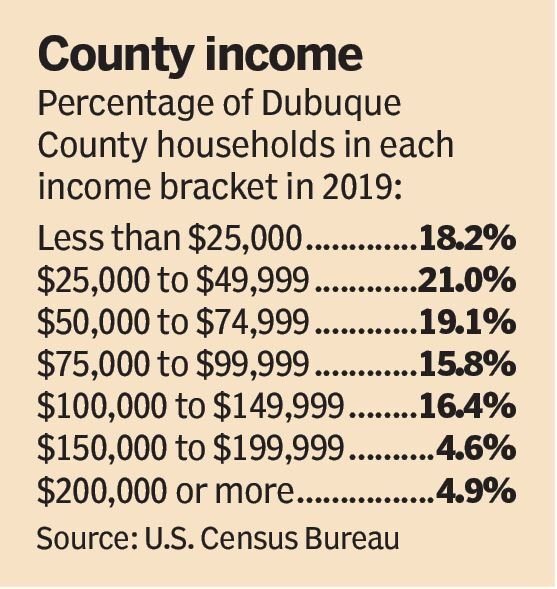Notebooks in hand and ready to talk numbers, almost 70 people gathered at the Community Foundation of Greater Dubuque office on Thursday.
During the foundation’s annual “data walk” event, the public was invited to view charts and tables plastered onto the walls of the foundation’s office in the Roshek Building. This year’s focus was data on the theme of employment and equity, including indicators of the pandemic’s impact on workforce availability and average wages compared to Dubuque’s cost of living.
“The focus of the data walk is to kind of take a look at the contrast between what it takes to live in Dubuque and then what wages have been like, what the economy has been like and how those things match up and how they don’t,” said foundation Director of Community Initiatives Alex Baum.
A press release issued about the event noted that “the data is intended to create discussion and collaboration around developing innovative, localized solutions to complex community challenges, a primary focus of the community foundation’s work.”
Attendee Jessica Bushman eyed a chart that showed the range of hourly wages by industry.
“When you look at the numbers of wages that are paid, it really points out that there are a lot of lower-income individuals,” Bushman said.
Cutting through the long chart was a line indicating the wages an adult with a child would need to survive in Dubuque. Many of the ranges dipped below the “survival” budget figure.
“It says a lot right there,” Bushman said, pointing to the line.
Using the United Way’s ALICE methodology, the foundation calculated how much a Dubuquer would have to make to pay for household essentials. The latest ALICE, or Asset Limited, Income Constrained, Employed, calculations are from 2018.
Baum said community foundation officials plugged in fresh data to find 2021 estimates.
A single adult living in Dubuque with a child too young for school and in need of child care would need to take home $41,491 to meet average local housing, food, transportation and health care costs. The total climbs to $73,842 for a family of two adults and two young children in child care.
According to U.S. Census Bureau data shared by the foundation, about 27% of Dubuque County households had income of less than $35,000. About 58% took home less than $75,000.
Anderson Sainci, director of the City of Dubuque’s Office of Shared Prosperity, said the data reflected the work that still needs to be done in the community.
He said that, in his discussions with other attendees, people remarked on the difference between the wages needed to survive and the wages needed for a household to achieve stability.
“(The event) is very helpful because we believe it’s not one institution or one individual who can solve poverty,” Sainci said.
Other posters examined the impact of the pandemic on unemployment and the labor force.
From 2019 to 2021, the number of unemployed individuals in Dubuque County increased by 500, while the labor force, or the number of people working or actively looking for work, decreased by about 2,500.
Attendee Delia Hollbach pointed to the pandemic labor force data, high child care figures and income disparities by race as some of the information that stood out.
“I wanted to find out where Dubuque is at,” she said.
Hollbach came with partner David Langolis. He noted that information about the transportation struggles of individuals without a car and without access to public transportation reflected his experiences as an Uber driver.
“There’s a transportation need with the lower end of the economic spectrum,” Langolis said.
Interspersed between the charts and numbers were stories about local residents grappling with poverty and low wages, shared by nonprofits such as Fountain of Youth, Tristate VIATS and the Salvation Army.
“Part of what we’re trying to do is to be able to show people in a more granular level what living in a low-income or poverty-income household is like in Dubuque,” Baum said.
As attendees left the event, they were invited to fill out post-it notes identifying other data they would like to see.
Kathy Weber, who works with students with disabilities at Loras College, noticed that the data displayed didn’t take disabilities into account.
Weber said pieces of the “survival budget,” such as child care, health care or transportation costs, would be even higher for a family with individuals with disabilities.
“Part of my concern would be that we make sure that is represented,” she said.




